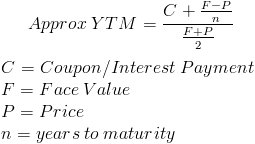Each of the following 3 bonds matures in 12 years:
I understand yield of maturity is calculated through the equation:
Since the yield of maturity for each bond is 7%, wouldn't that mean each bond would have equivalent value (assuming the investor had no other considerations such as needing money sooner or lower capital gains)?
However, I'm not sure why this is the case since in my (likely erroneous) opinion, Bond C would be more valuable than the other two bonds. I think Bond C would return the most profit as the investor would pay $1241 and receive $100 * 12 + $1000 = $2200 (for a profit of $959) and Bond A would return the least profit as the investor would pay $759 and receive $40 * 12 + $1000 = $1480 (for a profit of $721).
Could someone explain why I'm wrong please?


